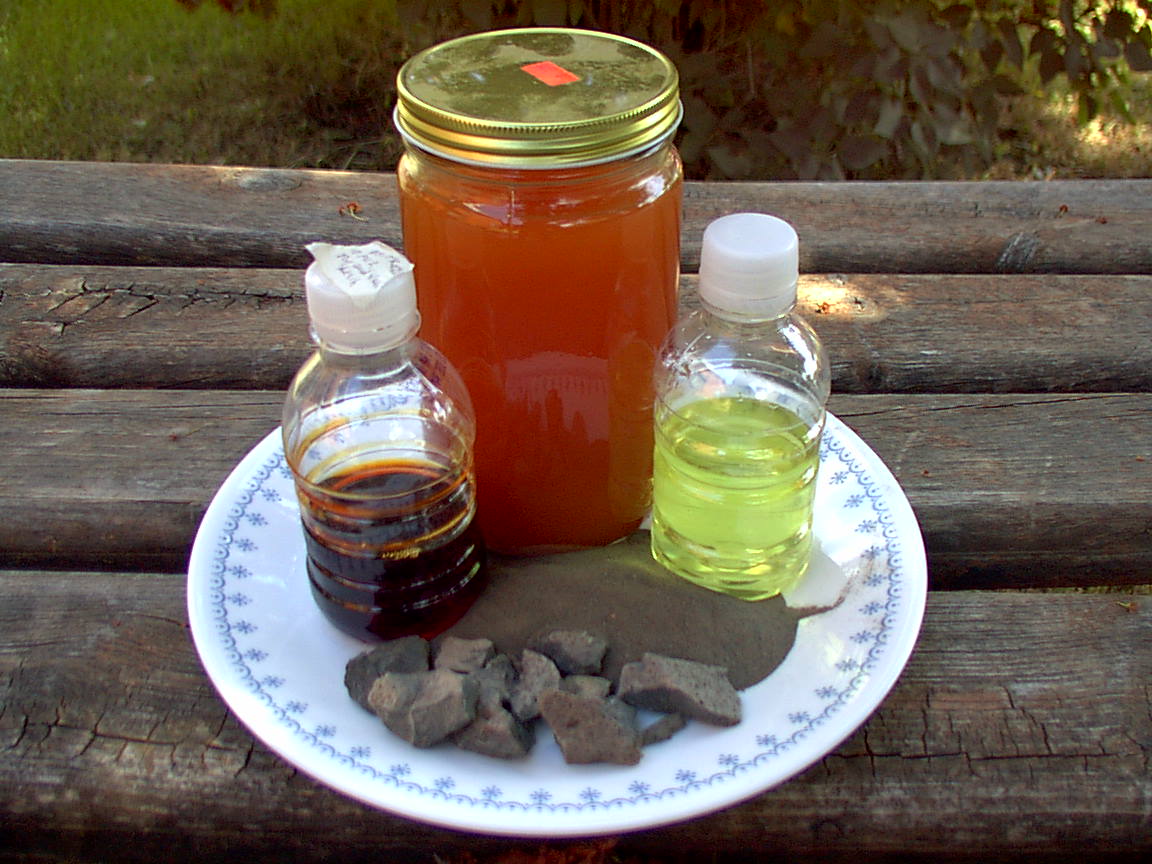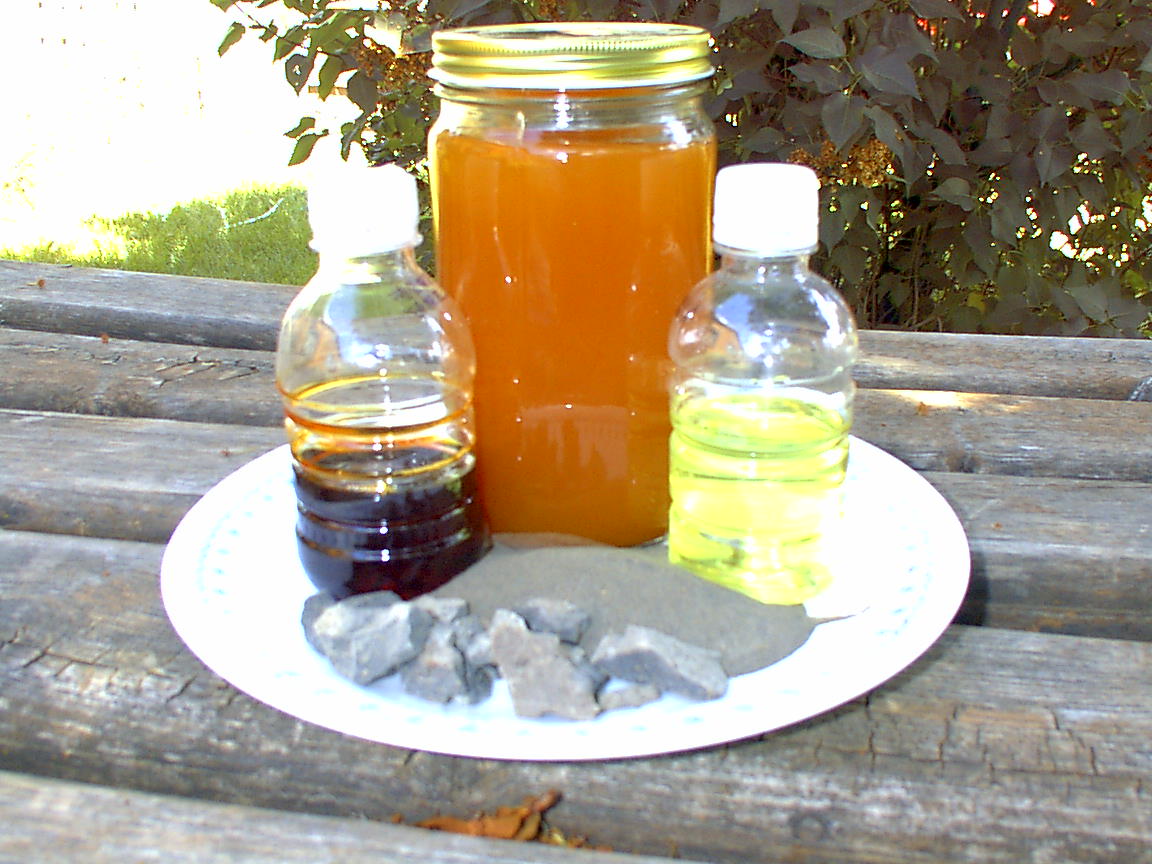I have recently become aware of an excellent
source
for the ORMUS elements. This source is a rock powder which contains the
m-state elements in approximately the following ratios:
|
|
|
|
|
29%
|
|
|
29%
|
|
|
23%
|
|
|
17%
|
|
|
3%
|

HR source rock in front with powdered HR in center of plate
The chemicals and procedures involved
with
the following process are dangerous and can form toxic gasses. You
should
not attempt this process if you are unfamiliar with the safety
procedures
involved in working with these materials and procedures.
Here is the method for making the "HR" m-state
liquid:
Take about 2 pounds or 900 mg (about 2 cups) of
rock
powder and add 16 cups (about 4 liters) of 1% HCl. Add an ounce of 1% H2O2.
Then add 200 mg of calcium hypochlorite with 70% available chlorine
(from
pool/spa dealer) dissolved in distilled water. This is dissolved at
about
two teaspoons in a quart of distilled water and dripped in over a
period
of a week. The originator of this procedure puts it in a saline
solution
bottle with a small needle for the drip so that it will drip in over a
period of a week. The pH of the solution should be at about 0.1.
Add 3% by weight of salt to the liquid mix to
bring
the mix to 3% salinity. Drip 1% H2O2 into the
solution
for five days. The originator uses about 10-15 ml of 35% H2O2
in a beer bottle full of distilled water. He sucks a portion of this
into
a syringe with a needle allowing some air in the syringe so that
fluctuations
in temperature will pump the drip. The ORP (Oxidation/Reduction
Potential)
should be maintained at 400 mv and should not exceed 500 mv.
The mix should be tumbled continuously or
shaken/stirred
8 to 10 times per day for 5 days and 2 times per day for 7 days
thereafter.
At one week add sufficient 1% HCl to bring the mix
back down to pH 0.1. Also at one week add an additional 200 mg amount
of
calcium hypochlorite using the same procedure specified above. Let this
mix sit for two more weeks shaking twice a day.
This will result in a grass green solution and
undissolved
solids. Pour or siphon off the clear liquid and filter it to remove all
suspended solids. Take the filtered liquid and bring the pH up to
1.9. If at pH 1.9 you get a beautiful deep purple color like
Concord
grape juice, toss the solution as it has gone to metal chloride. You
should
still have the green color at pH 1.9. Let this solution sit for a
couple
of hours.

Bottle on left contains purple chlorides which have gone metallic
Center bottle contains orange precipitate at pH 6.5
Right bottle contains green solution at pH 0.1
Next we drop out certain remaining metals from the
solution. These metals (which include iron and nickel) will drop out if
you bring the pH of the solution up to 2.8 and raise the ORP to 900 mv
using 35% hydrogen peroxide. This is necessary to convert metal
chlorides
in solution to metal oxides which will drop out of solution. Ordinarily
these metals don't drop out of solution till around pH 7 but the
peroxide
oxidizes them sufficiently that they drop out at this low pH.
If you bring it up to pH 2 slowly, and then let it
rest for a couple of hours you will get some precipitate as you bring
it
further up to pH 4. After you bring it up to pH 4 let it rest for
at least four hours. After four hours adjust the pH up to 6.5 using a
weak
solution of sodium hydroxide. If you bring the pH up slowly using a
very
dilute solution of sodium hydroxide you should be able to get a clear
final
product. The sodium hydroxide solution should be at a pH of around 9
when
you drip it into the HR solution.
All of these processes are done with sodium
hydroxide
mixed with water at the rate of one pound of sodium hydroxide per
gallon
of distilled water.
This liquid will be orange/brown in color. While
working
and storing this liquid it is best to keep it in a cardboard box inside
of a cheap steel can.
The HR method can be used on any rock which
contains
the ORMUS elements and which does not contain toxic metals. You can
obtain
rock which generally meets these criteria by purchasing paramagnetic
"rock
dust" soil supplements. We have confirmed a direct correlation between
the paramagnetic properties of a given soil or rock source and the
m-state
content of that source. You will want to be sure that the paramagnetic
measurements are high (above 500 or so) and that the assay provided by
the rock dust supplier does not include significant amounts of lead,
arsenic,
nickel and other toxic metals. You can find information about
paramagnetic
soil supplements through organic gardening suppliers. A list of rock
dust
suppliers can be found at:
http://www.attra.org/attra-pub/orgfert.html#nonphosphates
You can find more information about the connection
between paramagnetic materials and the m-state materials in my article
at: